Minimalist room lighting is about maximal utilization of accessories while using just as few as possible for the most effective feel.
Lighting is much more than just a general means of illuminating up at night. First, it defines the ambiance, alters the look of surfaces, and becomes that cozy layer between a person and a floor.
If you tend to get overwhelmed by elaborate objects in your home, then simple and elegant minimalistic lighting can be your ultimate solution. It is time to discover how you can introduce this modern and practical design into your house.
Why Minimalist Lighting?
What we surmised from the article is that minimalism is about giving a house an airy feel. Adding minimalist lighting can:
- Make the room look more beautiful
- Reduce visual clutter
- The items offer convenient and multiple-use lamps
This is quite a contrast from conventional illuminations that would embrace hefty mounting techniques and elaborate accessories.
Key Elements of Minimalist Lighting
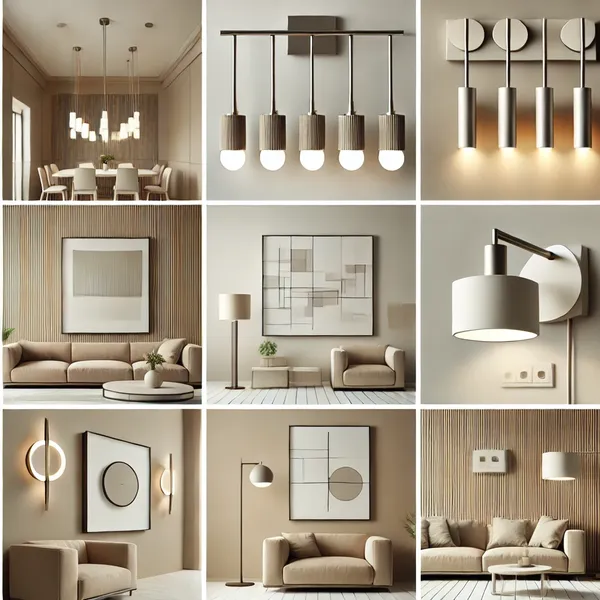
To achieve a minimalist look, you need to focus on a few critical aspects:
1. Neutral Colors and Materials
Minimalist types of lighting are soft white, black, and metallic-toned ones. This neutrality assists it in being an inconspicuous part of your space or environment.
Such materials as glass, metal, and wooden products are known to be used in the production of gadgets. They have a contemporary appearance and can be worn without anyone really noticing them.
2. Clean Lines and Simple Shapes
Straight lines and geometric patterns most characterize contemporary light fixtures. Or, for example, thin drops appropriate for sitting areas, round lamps for wall mounting, or rectangular lamps for a table.
Its simple forms do not overshadow the space where it is located or the purpose for which it is meant.
3. Layered Lighting
As we already know, minimalism should be combined with layers, and that goes for lighting as well. Use a mix of:
- General lighting (near ambient)
- Local lighting (light specifically for a particular activity)
- Emergency lighting: Every building should have at least one of the following lighting systems.
Thus, it provides functionality alongside balance and ensures that your room meets all the required standards.
Best Types of Minimalist Room Lighting
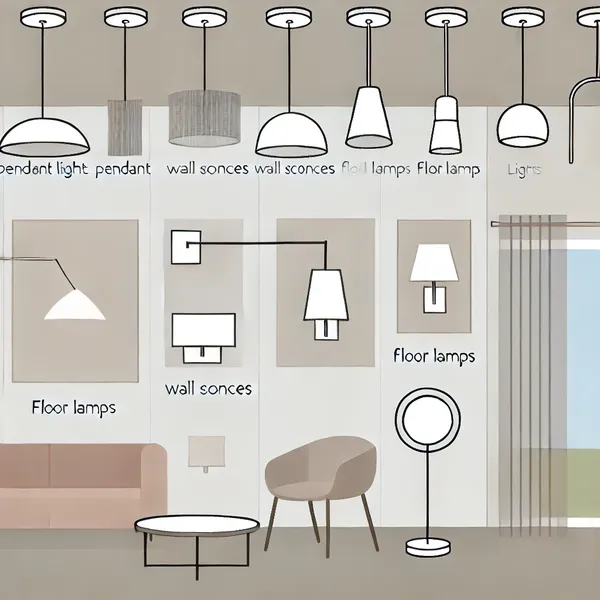
Indeed, one can easily find many solutions for minimalist lighting. Here are some of the most popular:
1. Pendant Lights
Pendant lights are installed on the ceiling, while flush mount lights are mounted directly to the ceiling, and these emit specific light. They are ideal for use over kitchen islands, dining tables, or even by your bedside table.
- Select long, individual bulb types to avoid clutter in the interior.
- Make clustered pendants, for they are simple but make a decisive say.
2. Wall Sconces
Next-to-wall sconces are particularly appropriate when it comes to providing ambient lighting. They can be installed right on the walls of the bedroom, in the hallway, or above the mirror in the bathroom.
Specifically, they should be slim designs that describe the contours of the wall and emit only a soft, lateral light.
3. Recessed Lighting
Recessed lights are mounted into the ceiling, thus making the fixture blend with the ceiling surface.
These are perfect for areas where you would like to have some form of lighting but want to avoid having to deal with lights all vested around the room.
Place them in living rooms, kitchens, and hallways and get a minimalist, contemporary style.
4. Floor Lamps
A bare floor lamp can create an impressive uplift and illumination. Choose boutiques with subtle legs and designs that favor subdued colors such as white, black, or grey.
They are great for reading nooks or occasional accessories in the living rooms.
5. Table Lamps
Simple table lamps are valuable objects and, at the same time, look good. Simply put them on desks, side tables, or console tables to have focused light in the specific areas they require it.
Choose lamps with plain bases or the least complex designs possible and matte ECs or lampshades.
How to Choose the Right Lighting for Your Space
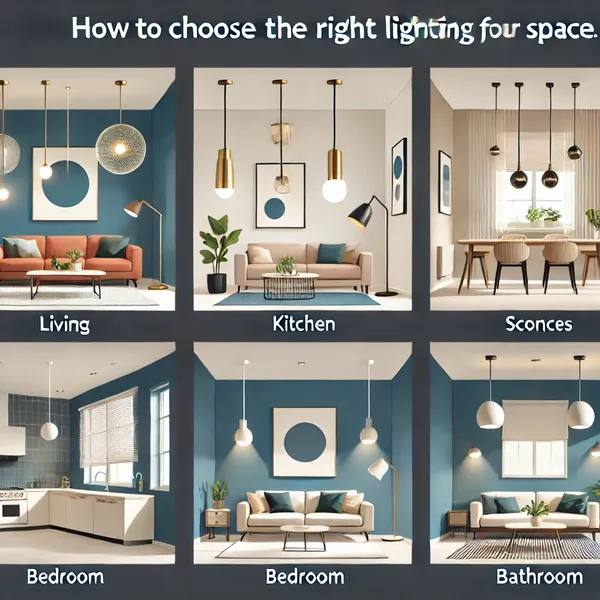
Choosing the appropriate minimalist room lighting solution involves three factors: area, purpose, and character of the space. Here’s a quick guide:
Living Room
This is your fun area for leisure and recreation, so you should have general and opening lighting designs.
- For general light, use recessed lighting or a central pendant lamp.
- You should install decorative lamps or a table on the floor to form comfortable corners.
Bedroom
Sleek bedrooms should be relaxing. Use soft, layered lighting.
- Bedside lamps should be put in context so that you may put pendants or sconces beside the bed.
- If lighting is required at particular places like reading places, then it is wiser to get a floor lamp.
Kitchen
Kitchens have to have bright, direct light. First of all, task and ambient lighting will help to create a proper working environment.
- Another good idea is to install pendant lights over the island.
- Place under cabinet lighting in order to bring light to counters.
Bathroom
From the above list, it can be seen that the bathroom should have recessed lights and sconces. Make sure your lighting is practical but also calming.
- Sconces should be placed next to the mirror to allow similar lighting.
- Dimmable recessed lighting should be used to give the bath a relaxing experience.
Home Office
For productivity, task lighting can work wonders. A simple desk lamp is what you need to deploy to achieve work focus.
How to Design a Simple Lighting Plan
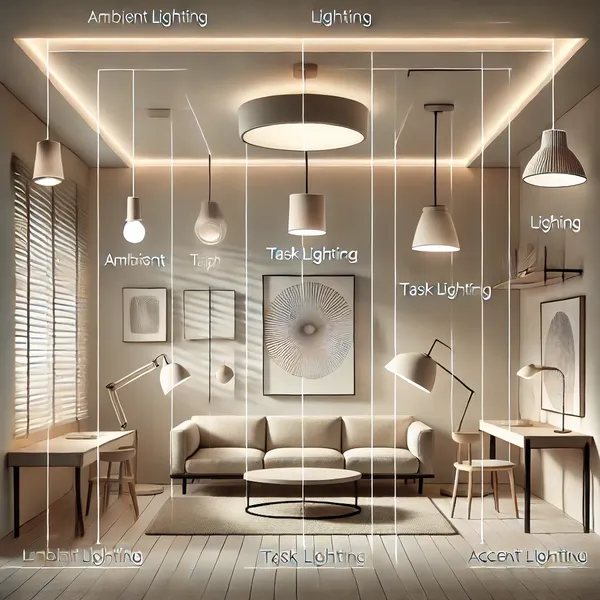
It’s not hard to get the perfect minimalist room lighting on. Follow these tips to create a stunning setup:
1. Prioritize Function Over Form
Minimalist lighting goes beyond the aesthetics. Every light needs to be justified with its being. Ask yourself:
- Is this fixture bright enough?
- Is it placed at the right place, the right spot?
2. Use Dimmers for Flexibility
Switches can differ and allow for the regulation of the brightness of the light, which is more favorable. For a work setting, it is bright to light up when necessary, or for an evening movie or family time, it can be dimmed.
3. Keep It Balanced
Put only a few lights in one place or space. However, do it evenly across the house, particularly in the room, so that there will be no cluster of light sources. This makes the interior look balanced and harmonized.
4. Embrace Negative Space
Speaking of negative space, it cracks in minimalism as well, regardless of how large the fixtures are. Avoid anything that has to do with curtains or covers for your walls or your ceilings; they are brilliant when left open.
5. Choose LED Bulbs
They include LED bulbs because they are energy-saving and have a long life span. They also are available in different color ranges and warm or cool temperatures.
The Power of Light in Minimalism
One of the most essential elements of any minimalist design is lighting. It can:
- Emphasize architectural elements
- Create cozy, inviting spaces
- Make small rooms feel larger
In this case, select appropriate fixtures and then create a practical arrangement with them to convert your house into a minimalist home.
Common Mistakes to Keep in Mind When Designing Minimalist Lighting
While minimalist lighting is straightforward, there are a few common pitfalls to avoid:
1. Overcomplicating the Design
Stick to simple, clean lines. Only use fixtures that are simple and have a minor detail.
2. Ignoring Layered Lighting
It is unwise to use one type of lighting in your home because it makes the environment quite dull. Don’t forget to use multiple layers of light sources for depth and dimensionality.
3. Choosing the Wrong Bulbs
If the bulbs are too bright, they will spoil the movie. They are too dim; they will also do the same. Avoid lampshades with a glaring and unnatural hue.
4. Skipping the Dimmer Switch
With it, you can be a bit artistic with your lights, but without it, you can’t even control how bright or dim the lights are. You can also use dimmer switches to put the light at whatever level feels comfortable to you.
Minimalist Lighting on a Budget
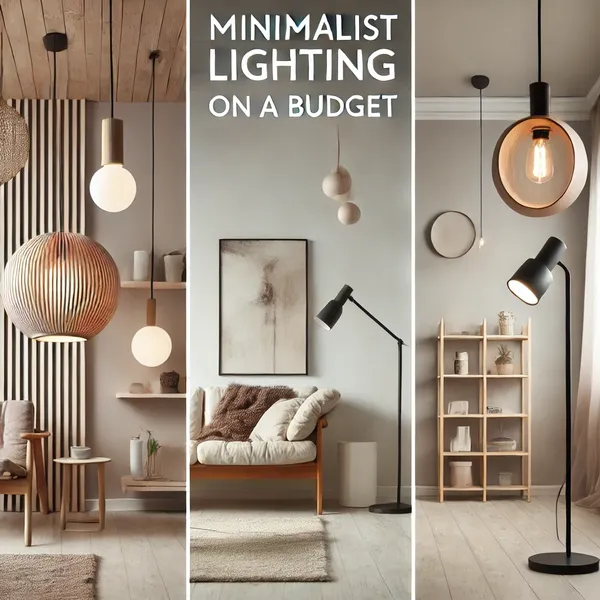
Minimalist is not expensive; here, you can find some tips on how to get a minimalist room lighting look without having to pay a fortune. Here’s how to keep costs down:
1. Shop Secondhand
Thrift shops or various online stores must have simple accessories that can be bought and repainted in a slight black color. Many times, you can get genuine products that are cheaper than what is frequently advertised.
2. DIY Your Fixtures
Depending on the direction of the light, it is possible to manufacture your minimalist light fixtures. For instance, convert a plain wooden frame into a beautifully artistic pendant.
3. Focus on Key Areas
Reduced expenditure on lighting is okay, but if it’s your final means, ensure that the areas of high importance, such as the living room or kitchen, get enough light.
4. Use LED Strips
LED strip lights can be easily installed at a cheap cost due to their portability. That is, place them under cabinets, behind TVs, or along shelves for a modern and minimalistic look.
Conclusion
Minimalist room lighting can be described as simple, practical, and aesthetically pleasing.
No frills, no gimmicks, just a clean line, neutral color scheme, and layers of lighting would make for a modern yet comfortable space.
In this case, you do not have to worry about your home’s appearance and appearance since minimalist lighting suits any room perfectly.
So, what are you waiting for? Begin your minimalist lighting experience now and turn that cluttered area into a beautiful haven.